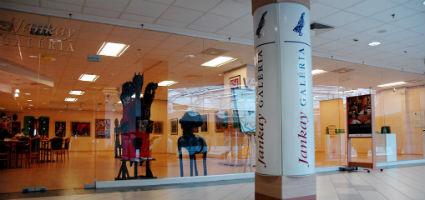2024. November 21. Thursday
Jankay Compilation and Kortárs Galleria - Békéscsaba
 |
Address: 5600, Békéscsaba Andrássy út 37/43.
Phone number: (66) 524-656
E-mail: jankaygaleria@t-online.hu
Opening hours: Tue-Sun 9-18
|
Tibor Jankay's character drawing to spiritualism turned his Sun imagery into something unique during the years in the USA, due to which this is a more remarkable type of iconography and more in quantity in his art than at the most of his contemporaries.
At the beginning, he mostly depicted the Sun in a realistic way as a celestial body, later it was more often depicted as a source of light. In these pictures the shape of the Sun conveys more meanings. For the figures in his work "Thinkers in Sunshine" (1940s) light is also a beam of hope promising a better life for the anguished. Another painting "Fugitives in Boat" (1948) has the same purpose, however we can notice a novelty in the construction of this picture. The composition of the work is created by the sunbeams. The lines of beams intersect the surface of the picture as a constructive net. In the 1960s, as he worked as a professor and later the senior lecturer of the faculty of arts in Pepperdine University, Los Angeles, his art became more serious, plenty of exquisite works with characteristic atmosphere were created. His suggestive masterpiece coming from this period is "Blue Forest" (1966) in which he combined the chilliness of blue with the mysteriousness of the streak of light.
He applied many kinds of techniques to intensify the determinant role of the Sun in his works. In some of his works beams are inscribed across the wallboard or canvas ("The Birth of Los Angeles", 1976, the illustration on this page), in others the sun-disk pulses letting many circles be seen around itself. In some works, on the contrary, the Sun is only a circle which is filled with the colour of the background or the master divided it into two parts depicting the Sun and the Moon together in this way. We know of the existence of Sun-cultures already in the ancient times, illustrations of the Bible, the Sun and the Moon together and their depiction next to each other, are known from the middle ages. One of Jankay's most frequent motives is arranging the two elements in one form; this can be seen in his works such as "Black and White" (1986) and "The Sun and the Moon" (1988).
The roundish shape of the Sun appears on his ceramics as well. In case of female figures and especially female portraits, he preferred the circlular compositions, the faces blessed with the circular Sun's roundness ("The Sleeping Sun", around 1970) The renewed permanent exhibition offers an overview from the artist's works connected to this theme to the visitor.
At the beginning, he mostly depicted the Sun in a realistic way as a celestial body, later it was more often depicted as a source of light. In these pictures the shape of the Sun conveys more meanings. For the figures in his work "Thinkers in Sunshine" (1940s) light is also a beam of hope promising a better life for the anguished. Another painting "Fugitives in Boat" (1948) has the same purpose, however we can notice a novelty in the construction of this picture. The composition of the work is created by the sunbeams. The lines of beams intersect the surface of the picture as a constructive net. In the 1960s, as he worked as a professor and later the senior lecturer of the faculty of arts in Pepperdine University, Los Angeles, his art became more serious, plenty of exquisite works with characteristic atmosphere were created. His suggestive masterpiece coming from this period is "Blue Forest" (1966) in which he combined the chilliness of blue with the mysteriousness of the streak of light.
He applied many kinds of techniques to intensify the determinant role of the Sun in his works. In some of his works beams are inscribed across the wallboard or canvas ("The Birth of Los Angeles", 1976, the illustration on this page), in others the sun-disk pulses letting many circles be seen around itself. In some works, on the contrary, the Sun is only a circle which is filled with the colour of the background or the master divided it into two parts depicting the Sun and the Moon together in this way. We know of the existence of Sun-cultures already in the ancient times, illustrations of the Bible, the Sun and the Moon together and their depiction next to each other, are known from the middle ages. One of Jankay's most frequent motives is arranging the two elements in one form; this can be seen in his works such as "Black and White" (1986) and "The Sun and the Moon" (1988).
The roundish shape of the Sun appears on his ceramics as well. In case of female figures and especially female portraits, he preferred the circlular compositions, the faces blessed with the circular Sun's roundness ("The Sleeping Sun", around 1970) The renewed permanent exhibition offers an overview from the artist's works connected to this theme to the visitor.